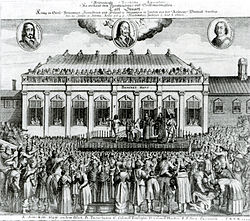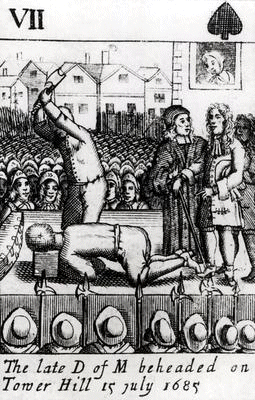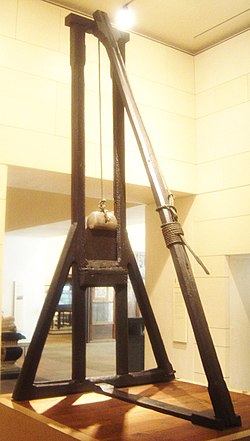The following is a list of people who were beheaded, arranged alphabetically by country or region and with date of decapitation. Special sections on "Religious figures" and "Fictional characters" are also appended.
Contents
- Austria
- Azerbaijan
- Brazil
- Canada
- Central African Republic
- China
- Chile
- Croatia
- Denmark
- Democratic Republic of the Congo
- Ecuador
- Egypt
- England
- Normans and early Plantagenets
- Wars of the Roses
- Tudors
- James I and Charles I
- Civil War
- Commonwealth
- Restored Stuarts
- European New World colonies
- Bolivia
- Brazil 2
- British North America
- Haiti
- Mexico
- Panama
- Peru
- Finland
- France
- Ancien Régime
- Revolutionary period
- First Republic
- Restoration
- Third to Fifth Republics
- Georgia
- Germany
- Pre-20th century
- Weimar Republic before 1933
- Nazi Germany
- Great Britain
- Hungary
- India
- Indonesia
- Iraq
- Ancient Mesopotamia
- Umayyad era
- Abbasid era
- Modern
- Iceland
- Iran
- Ireland
- Israel
- Italy
- Ancient Rome
- Medieval Italy
- Later Italy
- Japan
- Home islands
- Japanese-occupied territories (20th century)
- Modern Japan
- Jordan
- Korea
- Libya
- Morocco
- Netherlands/Belgium
- Norway
- Pakistan
- Philippines
- Poland
- Portugal
- Russia
- Saudi Arabia
- Scotland
- Serbia
- Spain
- Sri Lanka
- Sweden
- Syria
- Switzerland
- Turkey
- Byzantine era
- Ottoman era
- Republic era
- Ukraine
- United States
- Vietnam
- Wales
- Religious figures
- The Bible
- Catholic saints
- Greek mythology
- Sikh
- Hindu
- Fictional characters
- See also
- References
These individuals lost their heads intentionally (as a form of execution or posthumously). A list of people who were decapitated accidentally, including animal-related deaths, can be found at List of people who were decapitated.






































